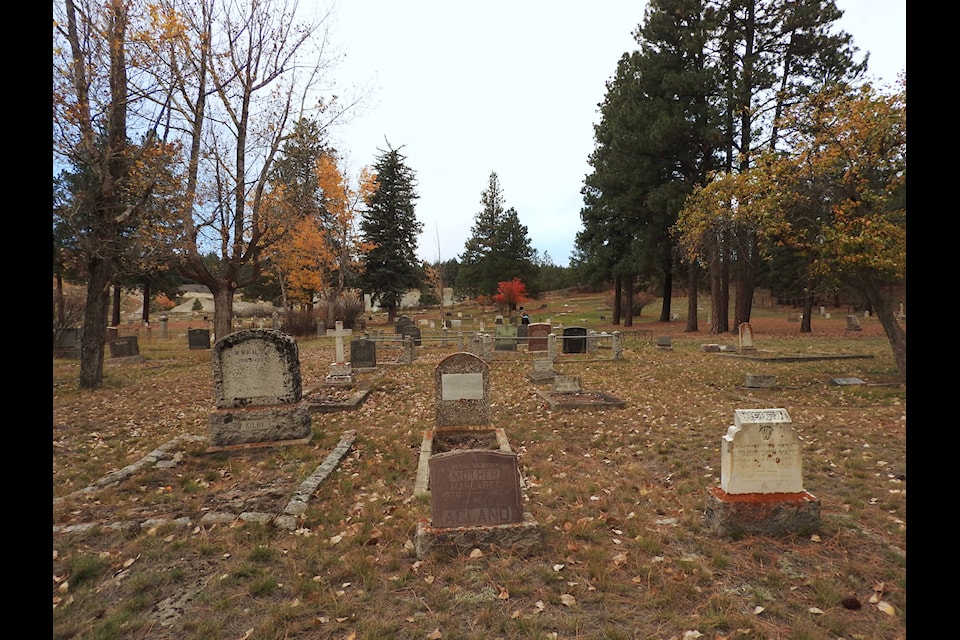Behind every gravestone is a story, and Cranbrook’s Old General Cemetery is no exception.
This historic locale, located on Borden Rd. West across from the much newer Westlawn Cemetery, is the oldest continuously standing graveyard in Cranbrook. It was surveyed by H. P Cummings and opened in 1899, growing from five to nearly seven acres within its first year of operation.
Today, there are 2,200 plots, many of which remain unidentified.
Plots from an even older graveyard, established where Baker Park currently rests, were exhumed and transferred to Old General Cemetery.
Old General Cemetery is a time capsule of local history. Its weathered and moss-covered gravestones memorialize historical figures and memorable characters who would have otherwise vanished into the depths of history to be forgotten.
The stories of the deceased provide a window into the history of the Kootenays.
It was a little more rough around the edges than the region we know and love today, but the lure of the mountains remained just as strong.
Cranbrook History Centre held a historic walking tour of the cemetery on Oct. 18 to uncover some of the history behind the people who were buried there.
“We wanted to use it as an opportunity to get to know the people who came before us that helped shape our history, an opportunity to maybe look at some people who have been overlooked and underrepresented in our community, that haven’t necessarily made it into exhibits or textbooks but are still worth a visit,” said program coordinator Kat Warman.
The mountains called famed adventurer Conrad Kain to Cranbrook. Kain was born in Austria in 1883 and his passion for climbing and guiding brought him west to the Kootenays. He was the first person to ascend Mount Louis, Mount Farnham and Bugaboo Spire, feats which he accomplished between 1913 and 1916. He worked as a guide with the Alpine Club of Canada and built a ski-run on Tunnel Mountain leading to Banff’s Caribou Street in 1910. He was instrumental in forming Banff’s first ski club in 1911.
The cemetery has a curious mix of people who upheld law and justice, and those who broke it.
May Reynolds, a local prostitute, was buried in the cemetery in 1900 — one of the first people to be laid to rest there.
“What makes May so interesting, is how respected and loved she really was. May was your local prostitute, but when she passed away, people from Cranbrook all came together and paid for her funeral service, her grave … Cranbrook was a little bit more rough and tumble than many of us think. Morals were a little bit more flexible. Cranbrook decided to look after May in her final years,” said tour guide Falyne Hauprich.
Frederick “Baldy” Ramsay Morris, a police officer, is buried not far from Reynolds. He started policing the streets of Cranbrook only a few years before the cemetery was built and one of the most memorable moments in his career happened while he was arresting a prostitute.
“He arrested a prostitute and had to take her to the CP station to get sent to prison. To make sure he could watch her, he decided to hand-cuff himself to her to take her to the station. At the station, people were wondering, ‘why are these two handcuffed together?’ What the prostitute started telling people, was that they were eloping and that’s why they were handcuffed,” Hauprich explained.
Individuals who made an impact on Kootenay colonial history, include Nils Hanson, a Swedish immigrant who helped create the community of Wasa, and Henry Seelye, a provincial ‘father of confederation’ who petitioned the government to have British Columbia incorporated into Canada.
Madeline Leone (Woodman), born 1910, claimed the Miss Canada title and ran for Miss Universe. She was laid to rest in the cemetery after tragically taking her own life in 1935.
A few members of the Leitch family, many of whom died in the Frank Slide, are buried at the site. On April 29, 1903, the slide claimed the lives of Alexander and Rosemary Leitch and their sons John, Allan, Athol and Wilfred. Their three daughters, Jessie, May and Marion, survived.
Marion, a baby, was found unharmed on a pile of rubble. She was erroneously reported as being the only survivor and having an unknown identity, which led to her being named Frankie Slide.
Marion attended the University of British Columbia to study French and music, and eventually moved to Nelson where she taught piano. She is buried with her husband in Nelson, however her uncle Archibald, who helped raise her after the disaster, is buried with the family at the Old General Cemetery.
The Leitch family had connections to Cranbrook through Archibald’s logging business.
Hauprich completed extensive research to learn the history behind the graves, which included consultations with local historians and searching for information through the Columbia Basin Institute of Regional History. She said that what amazed her, was how diverse the cemetery is.
“You had prostitutes who were fairly respected, like May Reynolds. You had people from Austria, like Conrad Kain. You had people from Sweden, like Nils Hanson. You just have a mumble jumble of different people who all came together to form Cranbrook as we know it,” she said.
